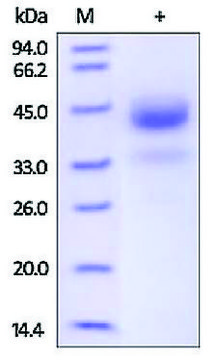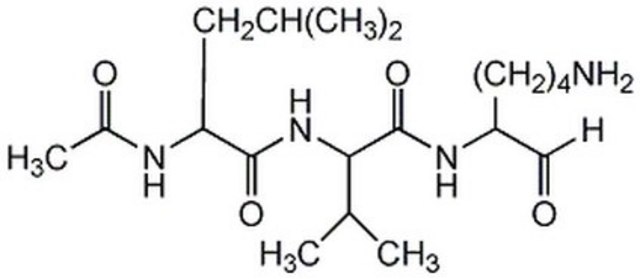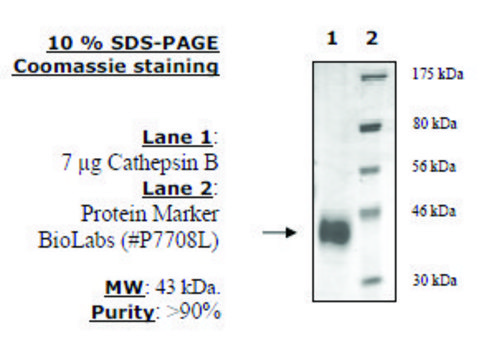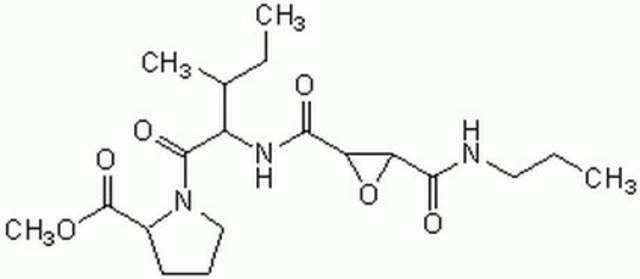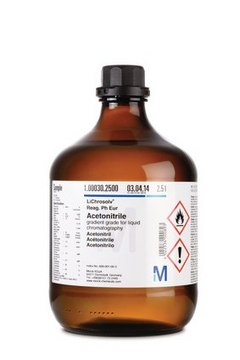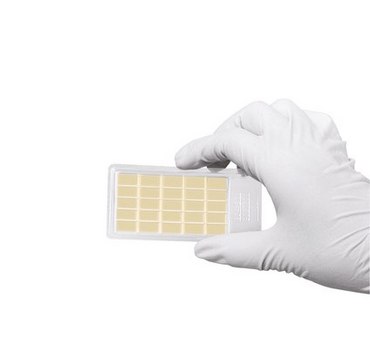219364
Cathepsin B, Human Liver
Cathepsin B, Human Liver, CAS 9047-22-7, is a purified native cathepsin B from human liver, purified by affinity chromatography. Upregulated in many types of tumors.
Sign Into View Organizational & Contract Pricing
All Photos(1)
Recommended Products
biological source
human liver
Quality Level
Assay
>95% (SDS-PAGE)
form
liquid
specific activity
≥50 units/mg protein
manufacturer/tradename
Calbiochem®
storage condition
OK to freeze
avoid repeated freeze/thaw cycles
shipped in
wet ice
storage temp.
−70°C
General description
Research area: Cell Signaling
Cathepsin B, Human Liver, is a native cathepsin B from human liver, purified by affinity chromatography. Cathepsin B is a lysosomal protease with endo/exopeptidase and a carboxydipeptidase activity. It is also known as cysteine cathepsin and belongs to the C1 family of papain-like enzymes. Cathepsin B like H, L, C, X, F, O and V is ubiquitously expressed in human tissues.
Optimal pH: 3.5-6.0.
Cathepsin B, Human Liver, is a native cathepsin B from human liver, purified by affinity chromatography. Cathepsin B is a lysosomal protease with endo/exopeptidase and a carboxydipeptidase activity. It is also known as cysteine cathepsin and belongs to the C1 family of papain-like enzymes. Cathepsin B like H, L, C, X, F, O and V is ubiquitously expressed in human tissues.
Optimal pH: 3.5-6.0.
Application
Cathepsin B, Human Liver has been used to assess its linker cleavage or proteolytic activity using an LC/MS MRM-based quantitation method.
Biochem/physiol Actions
Cathepsin B facilitates non-specific, bulk proteolysis within the acidic conditions of the endosomal/lysosomal compartment. Here, they break down both intracellular and extracellular proteins. Upregulation and secretion of cathepsin B have been shown to occur in many types of tumors and to correlate positively with their invasive and metastatic capabilities. Cathepsin B is shown to facilitate tumor invasion by dissolving extracellular barriers.
Packaging
Please refer to vial label for lot-specific concentration.
Warning
Toxicity: Standard Handling (A)
Unit Definition
One unit is defined as the amount of enzyme that will hydrolyze 1.0 µmol Z-RR-βNA per min at 40°C, pH 6.0 in the presence of DTT.
Physical form
In 50 mM sodium acetate buffer, 1 mM EDTA, pH 5.0.
Preparation Note
Prepared from tissue of individuals that have been shown by certified tests to be negative for HBsAg and for antibodies to HIV and HCV.
Reconstitution
Following initial thaw, aliquot and freeze (-70°C).
Other Notes
Kostoulas, G., et al. 1999. FEBS Lett. 455, 286.
Berquim, I.M., and Sloane, B.F. 1996. Adv. Exp. Med. Biol.389, 281.
Keppler, D., et al. 1994. Biochim. Biophys. Acta.1226, 117.
Musil, D., et al. 1991. EMBO J.10, 2321.
Sloane B.F. 1990. Semin. Cancer Biol.1, 137.
Berquim, I.M., and Sloane, B.F. 1996. Adv. Exp. Med. Biol.389, 281.
Keppler, D., et al. 1994. Biochim. Biophys. Acta.1226, 117.
Musil, D., et al. 1991. EMBO J.10, 2321.
Sloane B.F. 1990. Semin. Cancer Biol.1, 137.
Legal Information
CALBIOCHEM is a registered trademark of Merck KGaA, Darmstadt, Germany
WGK
WGK 2
Flash Point(F)
Not applicable
Flash Point(C)
Not applicable
Regulatory Information
新产品
Certificates of Analysis (COA)
Search for Certificates of Analysis (COA) by entering the products Lot/Batch Number. Lot and Batch Numbers can be found on a product’s label following the words ‘Lot’ or ‘Batch’.
Already Own This Product?
Find documentation for the products that you have recently purchased in the Document Library.
BinQing Wei et al.
Journal of medicinal chemistry, 61(3), 989-1000 (2017-12-12)
Antibody-drug conjugates (ADCs) have become an important therapeutic modality for oncology, with three approved by the FDA and over 60 others in clinical trials. Despite the progress, improvements in ADC therapeutic index are desired. Peptide-based ADC linkers that are cleaved
Lysosomal pathways to cell death and their therapeutic applications
Cesen MH, et al.
Experimental Cell Research, 1245-1251 (2012)
Lorna Kategaya et al.
Nature, 550(7677), 534-538 (2017-10-19)
The ubiquitin system regulates essential cellular processes in eukaryotes. Ubiquitin is ligated to substrate proteins as monomers or chains and the topology of ubiquitin modifications regulates substrate interactions with specific proteins. Thus ubiquitination directs a variety of substrate fates including
Vito Turk et al.
Biochimica et biophysica acta, 1824(1), 68-88 (2011-10-26)
It is more than 50 years since the lysosome was discovered. Since then its hydrolytic machinery, including proteases and other hydrolases, has been fairly well identified and characterized. Among these are the cysteine cathepsins, members of the family of papain-like
Our team of scientists has experience in all areas of research including Life Science, Material Science, Chemical Synthesis, Chromatography, Analytical and many others.
Contact Technical Service
